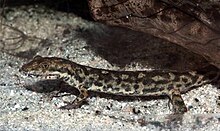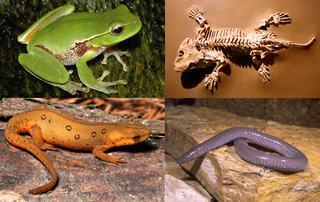
Amphibians are ectothermic, tetrapod vertebrates of the class Amphibia. All living amphibians belong to the group Lissamphibia. They inhabit a wide variety of habitats, with most species living within terrestrial, fossorial, arboreal or freshwater aquatic ecosystems. Thus amphibians typically start out as larvae living in water, but some species have developed behavioural adaptations to bypass this.

The palmate newt is a species of newt found in Western Europe, from Great Britain to the northern Iberian peninsula. It is 5–9.5 cm (2.0–3.7 in) long and olive or brown with some dark spots. The underside is yellow to orange, and the throat, unlike in the similar smooth newt, always unspotted. A dark stripe runs along the head and through the eyes. Breeding males develop a distinct filament on the end of their tail, strongly webbed hind feet, and a low, smooth crest on their back.

Plethodontidae, or lungless salamanders, are a family of salamanders. Most species are native to the Western Hemisphere, from British Columbia to Brazil, although a few species are found in Sardinia, Europe south of the Alps, and South Korea. In terms of number of species, they are by far the largest group of salamanders.

The Jefferson salamander is a mole salamander native to the northeastern United States, southern and central Ontario, and southwestern Quebec. It was named after Jefferson College in Pennsylvania.
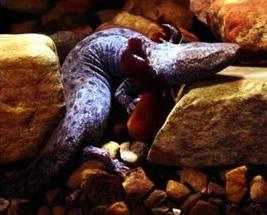
The common mudpuppy is a species of salamander in the genus Necturus. They live an entirely aquatic lifestyle in parts of North America in lakes, rivers, and ponds. They go through paedomorphosis and retain their external gills. Because skin and lung respiration alone is not sufficient for gas exchange, mudpuppies must rely on external gills as their primary means of gas exchange. They are usually a rusty brown color and can grow to an average length of 13 in (330 mm). Mudpuppies are nocturnal creatures, and come out during the day only if the water in which they live is murky. Their diet consists of almost anything they can get in their mouths, including insects, mollusks, and earthworms. Once a female mudpuppy reaches sexual maturity at six years of age, she can lay an average of 60 eggs. In the wild, the average lifespan of a mudpuppy is 11 years.
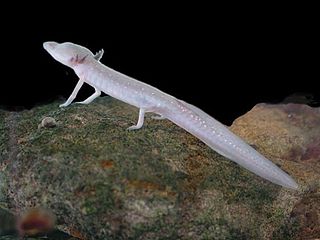
The Texas blind salamander is a rare cave-dwelling troglobite amphibian native to San Marcos, Hays County, Texas, specifically the San Marcos Pool of the Edwards Aquifer.

Ambystoma talpoideum, the mole salamander, is a species of salamander found in much of the eastern and central United States, from Florida to Texas, north to Illinois, east to Kentucky, with isolated populations in Virginia and Indiana. Older sources often refer to this species as the tadpole salamander because some individuals remain in a neotenic state. This salamander lives among the leaf litter on the forest floor, migrating to ponds to breed.

The Pyrenean brook salamander or Pyrenean newt, Calotriton asper, is a largely aquatic species of salamander in the family Salamandridae. It is found in the Pyrenees of Andorra, France, and Spain. The IUCN lists it as least concern.

The Corsican brook salamander or Corsican mountain newt is a species of salamander in the family Salamandridae. It is endemic to Corsica, an island in the Mediterranean Sea.

The Corsican fire salamander is a species of salamander in the family Salamandridae found only on the island of Corsica as an endemic species. In former times, this species was known as a subspecies of the widespread but continental-distributed fire salamander, which may appear quite similar.

The Oita salamander is a species of salamander in the family Hynobiidae endemic to Japan. Named after Oita Prefecture, its natural habitats are temperate forests, rivers, intermittent rivers, freshwater marshes, intermittent freshwater marshes, and irrigated land in western Japan. It is threatened by habitat loss, due to the increasing construction of homes within its habitat. The Oita Salamander is considered to be vulnerable by the (IUCN) Red List of Threatened Species with a declining population.
The northern banana salamander, also known as common dwarf salamander or rufescent salamander, is a species of salamander in the family Plethodontidae. It is found in the Atlantic slopes of Meso-America from San Luis Potosi, Veracruz, and northern Chiapas in Mexico continuing on to the southern part of Guatemala, Belize, and northern Honduras. However, its range south of Mexico is uncertain because the records may refer to other species.

The imitator salamander is a species of salamander in the family Plethodontidae. It is endemic to the Appalachian Mountains in the Eastern United States.
Ixalotriton parva, the dwarf false brook salamander, is a species of salamander in the family Plethodontidae. It is endemic to a small mountainous area of Mexico where its natural habitat is subtropical or tropical moist montane forests. It is threatened by habitat loss. There is some doubt whether this species should be classified as Pseudoeurycea parva or Ixalotriton parva.
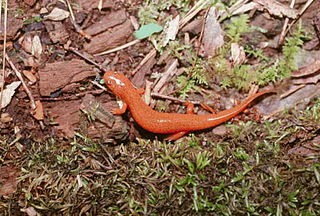
The mud salamander, is a bright red salamander of the family Plethodontidae. It is found in streams, seeps and swamps and underneath logs, rocks and leaves. It is endemic to the eastern half of the United States with one isolated population in central Mississippi. Mud salamanders have short stocky bodies ranging from 7.5 to 16 cm long. Body color ranges with age and locality with coastal mud salamanders being more dark and drab whilst inland mud salamanders are brighter and have more contrast against the black polka dots that sporadically pattern their bodies. In the earlier years of a mud salamanders life, they tend to have crimson colored body and unspotted stomachs, as they age the salamander becomes a dark red almost purple color and acquires a spotted stomach. mud salamanders have 16 to 17 costal grooves found along the sides of the salamanders body. These salamanders are ectothermic meaning that they cannot control their body temperature and it fluctuates with the temperature. The mud salamander is readily confused with two other species, the red salamander and the spring salamander. It can be distinguished from the Red salamander by having golden pupils and a shorter snout, and can be distinguished from the spring salamander by having a shorter body length and missing the nasal ridge associated with this species. There are four subspecies in the mud salamander complex, these are the Gulf Coast mud salamander, rusty mud salamander, Midland mud salamander and the eastern mud salamander.
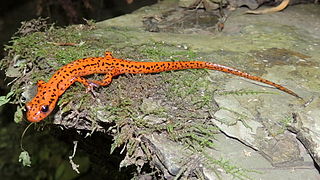
The spotted-tail salamander, also known as a "cave salamander", is a species of brook salamander.

A newt is a salamander in the subfamily Pleurodelinae. The terrestrial juvenile phase is called an eft. Unlike other members of the family Salamandridae, newts are semiaquatic, alternating between aquatic and terrestrial habitats. Not all aquatic salamanders are considered newts, however. More than 100 known species of newts are found in North America, Europe, North Africa and Asia. Newts metamorphose through three distinct developmental life stages: aquatic larva, terrestrial juvenile (eft), and adult. Adult newts have lizard-like bodies and return to the water every year to breed, otherwise living in humid, cover-rich land habitats.

The Montseny brook newt, Calotriton arnoldi, is a species of salamander in the family Salamandridae. It is endemic to the Montseny Massif in northeast Spain. Before it was formally described in 2005, it was mixed with the larger and more widely distributed Pyrenean brook salamander.
